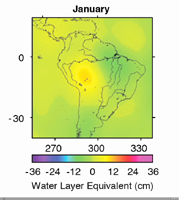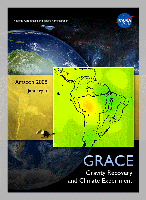Measuring Water Storage in the Amazon
 |  |
This image shows the Amazon basin in South America. The amount of water stored in the Amazon basin varies from month to month, and can be monitored from space by looking at how it alters Earth's gravity field. This series of images was produced using data from Gravity Recovery and Climate Experiment (GRACE) in 2008 and shows month-to-month water mass changes (relative to a three-year average) over the Amazon and neighboring regions. Oranges, reds and pinks show where mass is lower than average; greens, blues and purples show where mass is higher than average. The Amazon has distinct rainy and dry seasons, and the seasons show up clearly through the monthly maps. Notice also that the smaller Orinoco basin to the north of the Amazon has a distinctly different seasonal pattern.
NASA launched GRACE in 2002 to obtain high-resolution, global measurements of Earth's gravity field from space. After seven years, GRACE continues to reveal increasingly subtle changes in Earth's gravity field. These gravity variations reflect changes in the distribution of Earth's mass, including changes in water storage in river basins on land, changes in ice mass in Greenland and Antarctica, ocean mass changes, and even changes caused by large earthquakes. GRACE data are substantially improving our knowledge of important aspects of global change, including the climate consequences of a warming world.
As GRACE's twin satellites pass over features on Earth, the distance between the satellites changes ever so slightly in response to the mass of these features. Extremely sensitive instruments on GRACE can measure changes in the distance between the twin satellites to an accuracy of 1 micrometer (one-millionth of a meter), which is 20 to 100 times smaller than the width of a human hair. As GRACE orbits, it provides data for scientists to construct a new map of Earth's gravity field every month.
Data from GRACE help scientists monitor changes in water storage over large areas, as illustrated in the animation. Gravity changes correspond to redistribution in Earth's mass, and scientists can isolate the part that is caused by the movement of water. Hydrologists go a step further and combine information from GRACE with soil moisture and other data to isolate changes in groundwater storage, which is otherwise very difficult to measure, but whose monitoring has global societal impact. This also allows them, for example, to monitor monthly water storage changes in aquifers where appropriate.
GRACE is a collaborative endeavor involving the Center for Space Research at the University of Texas, Austin; NASA's Jet Propulsion Laboratory, Pasadena, Calif.; the German Space Agency and Germany's National Research Center for Geosciences, Potsdam.
